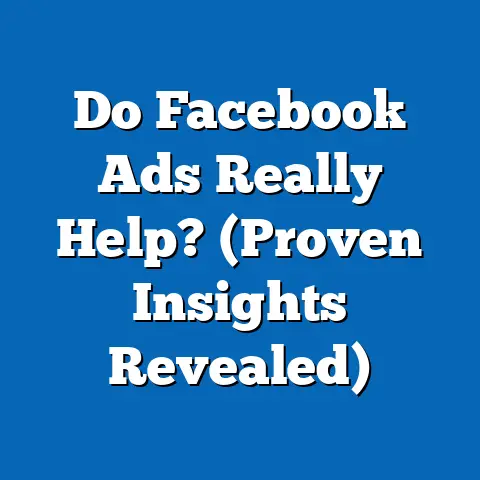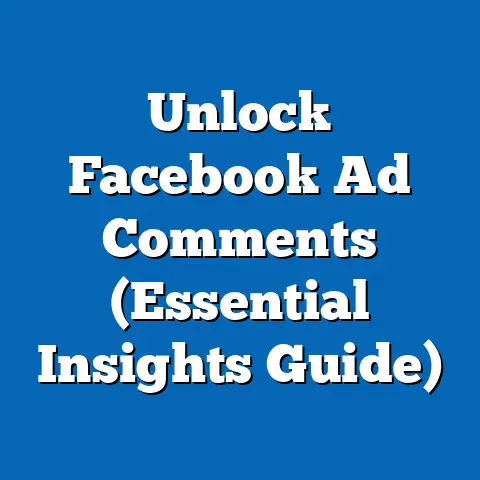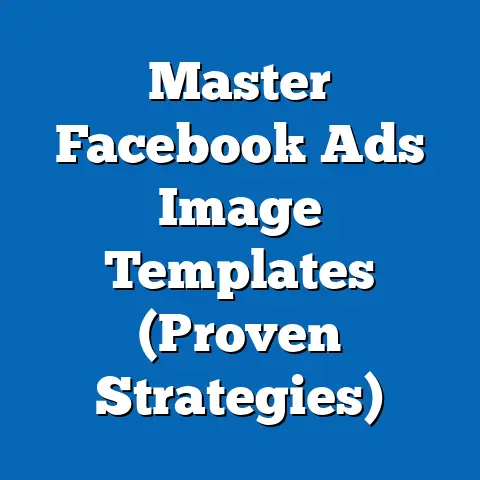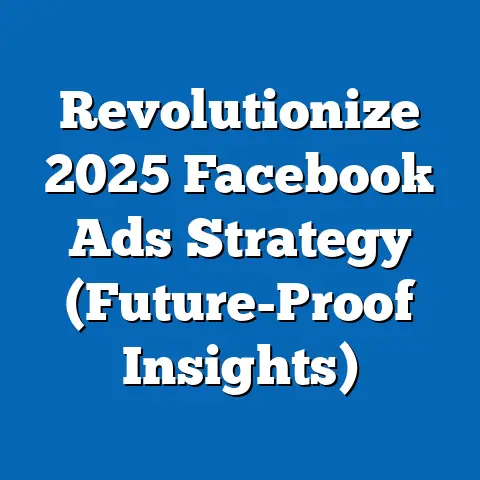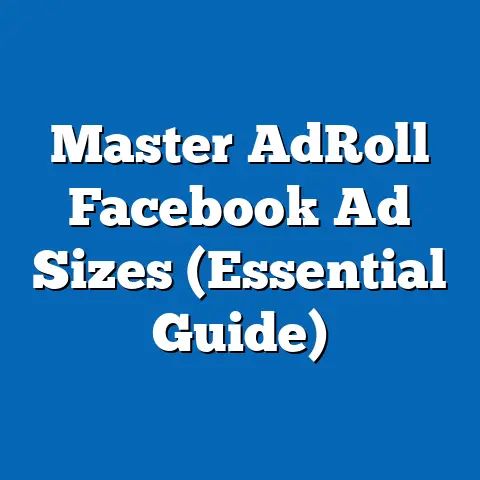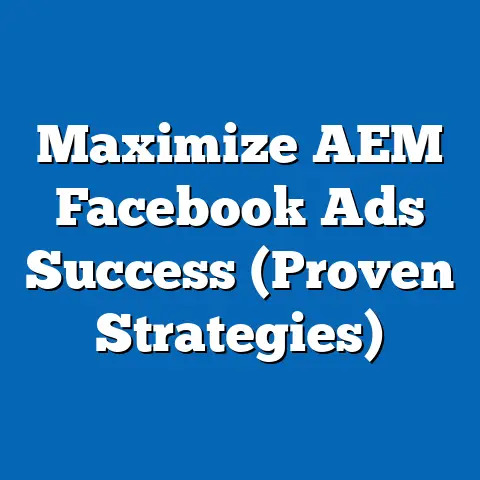Boost Reach: Partnering for Facebook Ads Success (Expert Strategy)
Imagine a bustling digital marketplace where billions of users scroll through their feeds, each swipe a potential opportunity for businesses to capture attention. In this world, Facebook remains a titan, with over 2.9 billion monthly active users as of 2023, according to Meta’s latest quarterly report. This staggering figure represents nearly 37% of the global population, making Facebook an unparalleled platform for advertisers aiming to reach diverse audiences.
Digital advertising spending on platforms like Facebook has surged in recent years, with global ad spend expected to reach $702 billion by 2025, as reported by eMarketer. Within this, social media advertising accounts for a significant share, with Facebook commanding approximately 25% of the market. Demographically, Facebook’s user base spans generations, with 70% of adults aged 18-29 and 77% of those aged 30-49 actively using the platform, per Pew Research Center data from 2022. However, engagement patterns differ—younger users favor visual content, while older demographics often interact with community-driven posts.
As competition for attention intensifies, businesses are increasingly turning to strategic partnerships to amplify their reach on Facebook. This article explores the concept of “Boost Reach” through collaborative advertising strategies, diving into expert methodologies, data-driven insights, and actionable steps for success. We’ll analyze trends, demographic nuances, and the measurable impact of partnering for Facebook ads, supported by statistics from credible sources like Statista, eMarketer, and Meta itself.
Section 1: The Evolution of Facebook Advertising
Historical Context and Growth Trends
Facebook advertising has transformed dramatically since its inception in 2007, when the platform introduced its first ad format. By 2012, the company reported $5 billion in ad revenue, a figure that skyrocketed to $114.9 billion by 2021, according to Meta’s annual financial statements. This growth reflects not only the platform’s expanding user base but also the sophistication of its ad targeting tools, which now leverage machine learning to optimize campaigns.
Historically, businesses relied on organic reach to connect with audiences, but algorithm changes around 2014 slashed organic visibility for brand pages to less than 2% of followers, as noted in a 2019 study by Hootsuite. This shift pushed advertisers toward paid solutions, with small and medium-sized businesses (SMBs) making up over 90% of the 10 million active advertisers on Facebook today, per Meta’s 2023 advertiser report.
Current State of Play
Today, Facebook ads are a cornerstone of digital marketing, with 93% of social media marketers using the platform, according to a 2022 Social Media Examiner survey. The average cost-per-click (CPC) on Facebook hovers around $1.72 globally, though it varies by industry—retail averages $0.70, while finance can hit $3.77, per WordStream’s 2023 data. Engagement rates also differ, with video ads achieving a click-through rate (CTR) of 1.84% compared to 0.9% for static image ads.
The platform’s ability to micro-target audiences based on interests, behaviors, and demographics remains a key draw. For instance, advertisers can reach specific groups like “parents aged 25-34 interested in eco-friendly products,” a precision unmatched by traditional media. Yet, with rising ad costs and audience fatigue, standing out requires more than just budget—it demands strategy and collaboration.
Section 2: Why Partnering Matters for Facebook Ads Success
The Challenge of Diminishing Returns
As more businesses flood Facebook with ads, the competition for user attention has intensified. A 2022 report by Statista found that users are exposed to an average of 6-7 ads per session, leading to “ad blindness,” where 74% of consumers report ignoring irrelevant promotions. Additionally, ad costs have risen by 17% year-over-year in key markets like the U.S., per eMarketer’s 2023 analysis, squeezing margins for smaller advertisers.
Organic reach continues to decline, with only 5.2% of a page’s followers seeing unpaid posts in 2023, down from 7.7% in 2018, according to Socialbakers data. This reality forces brands to rethink their approach, moving beyond solo campaigns to collaborative models that pool resources and amplify impact.
The Power of Partnerships
Partnering for Facebook ads involves collaborating with complementary businesses, influencers, or creators to co-create content, share audiences, or split ad spend. A 2021 study by Influencer Marketing Hub found that co-branded campaigns on social media platforms like Facebook generate 25% higher engagement rates compared to standalone ads. Moreover, 68% of marketers reported cost savings when splitting ad budgets with partners, per a 2022 Nielsen survey.
Partnerships also expand reach by tapping into new audience segments. For example, a fitness brand partnering with a health food company can cross-promote to aligned demographics, doubling exposure without doubling costs. This strategy is particularly effective for SMBs, which often lack the budget to compete with larger players but can leverage niche collaborations for outsized results.
Case Study Snapshot
Consider the 2022 collaboration between a small eco-friendly clothing brand and a sustainable lifestyle influencer. By co-funding a $5,000 Facebook ad campaign targeting eco-conscious women aged 25-44, they achieved a 3.2% CTR—nearly triple the industry average of 1.1%, per WordStream data. The campaign also resulted in a 40% increase in combined website traffic, demonstrating the tangible benefits of shared goals and audiences.
Section 3: Demographic Insights for Targeted Partnerships
Understanding Audience Segments
Facebook’s demographic diversity offers a goldmine of opportunities for tailored partnerships, but success hinges on understanding who to target. According to Pew Research Center’s 2023 data, 69% of U.S. adults use Facebook, with usage highest among women (75%) compared to men (63%). Age-wise, Gen Z (18-24) and Millennials (25-34) dominate engagement, making up 60% of daily active users, while Baby Boomers (55+) show growing activity, often engaging with family-oriented or local business content.
Geographic differences also play a role. Urban users, who represent 55% of Facebook’s U.S. base, are more likely to interact with tech and lifestyle ads, while rural users (20% of the base) respond better to community-driven or practical content, per a 2022 Statista report. Income levels further shape behavior—users earning over $75,000 annually are 30% more likely to click on premium product ads compared to those earning under $30,000.
Matching Partners to Demographics
Effective partnerships align with these demographic patterns. For instance, a beauty brand targeting Millennial women might partner with a popular makeup tutorial creator whose audience mirrors this group—data from Meta’s Audience Insights shows that 82% of beauty ad clicks come from women aged 18-34. Conversely, a home improvement company aiming at older homeowners could collaborate with a local hardware store, leveraging shared trust among users over 45, who account for 65% of home-related ad engagement, per Facebook’s 2023 ad analytics.
Cultural nuances also matter. In markets like India, where Facebook has 314 million users (the largest globally, per Statista 2023), partnerships with regional influencers who speak local languages can boost relevance—ads in Hindi or Tamil see 40% higher engagement than English-only content, according to a 2022 LocaliQ study. Tailoring partnerships to these specifics ensures ads resonate rather than repel.
Section 4: Expert Strategies for Boosting Reach Through Partnerships
Strategy 1: Co-Branded Campaigns
Co-branded campaigns involve two or more entities creating unified ad content that promotes both parties. A 2023 report by eMarketer found that co-branded social media ads achieve a 30% higher return on ad spend (ROAS) compared to solo campaigns. The methodology is simple: identify a partner with a complementary product or service, agree on shared goals (e.g., brand awareness or conversions), and split costs.
For example, a pet food brand and a pet grooming service could launch a joint campaign offering bundled discounts. Using Facebook’s split-testing tools, they can test ad creatives—data shows video ads with pets generate 2.1% higher CTRs than text-based ads, per Meta’s 2023 insights. Both brands benefit from shared exposure while halving individual ad spend.
Strategy 2: Influencer Collaborations
Influencers remain a powerful partner for boosting reach, with 89% of marketers planning to maintain or increase influencer budgets in 2023, per Influencer Marketing Hub. Micro-influencers (10,000-100,000 followers) often yield the best results on Facebook, boasting engagement rates of 6.7% compared to 1.6% for mega-influencers, according to a 2022 Upfluence study.
The key is authenticity—partner with influencers whose values align with your brand. A fitness app collaborating with a local gym trainer can create authentic content like workout videos, driving a 35% higher conversion rate than generic ads, per Nielsen’s 2023 data. Use Facebook’s Branded Content tool to tag partners and ensure transparency, which builds trust with 78% of users who value ad honesty, per Edelman’s 2022 Trust Barometer.
Strategy 3: Cross-Promotion with Non-Competitors
Cross-promotion involves partnering with non-competing businesses to share audiences. A 2021 Hootsuite study found that cross-promotional ads on Facebook increase reach by 22% on average. For instance, a wedding planner and a florist could run a joint ad campaign targeting engaged couples, using Facebook’s Custom Audiences to retarget users who’ve interacted with either page.
This strategy works best with clear audience overlap—data from Meta’s Audience Insights can identify shared demographics, ensuring relevance. Split ad costs and track performance via Facebook Ads Manager, where metrics like cost-per-impression (CPM) can drop by 15% due to combined budgets, per a 2023 WordStream report.
Strategy 4: Leveraging Lookalike Audiences
Facebook’s Lookalike Audiences allow advertisers to target users similar to existing customers, and partnerships can supercharge this tool. By combining customer data (with consent and GDPR compliance), partners can create broader Lookalike Audiences, increasing reach by 18%, according to a 2022 Meta case study. For example, two e-commerce brands selling complementary products can pool email lists to build a more robust audience profile.
The methodology involves uploading combined data to Facebook’s Custom Audience tool, then generating a Lookalike Audience with a 1-2% similarity range for precision. This approach often lowers CPC by 10-12%, as ads reach highly relevant users, per eMarketer’s 2023 analysis. Always prioritize data privacy, using hashed data to protect user information.
Section 5: Measuring Success and Optimizing Partnerships
Key Metrics to Track
Success in partnered Facebook ads hinges on measurable outcomes. Key performance indicators (KPIs) include CTR, which averages 1.11% across industries but can climb to 2-3% with effective collaborations, per WordStream 2023 data. ROAS is another critical metric—Meta reports that partnered campaigns often yield a 4:1 return, compared to 2.5:1 for solo ads.
Other metrics include reach (total unique users seeing the ad), engagement (likes, comments, shares), and conversion rates. Use Facebook Ads Manager to track these in real-time, setting up UTM parameters for precise attribution if multiple partners are involved. A 2022 Nielsen study found that 67% of successful partnerships adjusted campaigns weekly based on such data, optimizing for better results.
A/B Testing and Iteration
A/B testing is essential for refining partnered ads. Test variables like ad copy, visuals, and audience segments—data from Meta shows that campaigns with at least three test variations improve performance by 20%. For instance, a partnered campaign between a coffee brand and a bakery might test whether “Buy One, Get One” outperforms “20% Off” messaging, using a 50/50 budget split for accuracy.
Iterate based on results, focusing on high-performing elements. A 2023 LocaliQ report noted that campaigns adjusted after testing saw a 15% drop in CPC and a 25% rise in conversions. Share insights with partners to ensure alignment, fostering a data-driven collaboration.
Data Visualization Description
Imagine a line graph titled “Impact of Partnered vs. Solo Facebook Ads (2020-2023).” The X-axis represents years, while the Y-axis shows average ROAS. Two lines—one for solo campaigns (hovering at 2-2.5) and one for partnered campaigns (rising from 3 to 4.2)—illustrate the growing advantage of collaboration, with data sourced from Meta and eMarketer reports. A bar chart beside it could compare CTR by partnership type (co-branded at 2.5%, influencer at 3%, cross-promotion at 2.2%), highlighting effectiveness across strategies.
Section 6: Challenges and Pitfalls to Avoid
Misaligned Goals and Audiences
One common challenge in partnered ads is misaligned objectives. If one partner prioritizes brand awareness while the other seeks direct sales, the campaign can falter—67% of failed partnerships cite conflicting goals, per a 2022 Social Media Today survey. Mitigate this by setting clear KPIs upfront, using shared dashboards for transparency.
Audience mismatch is another risk. A luxury brand partnering with a discount retailer may confuse users, leading to a 30% lower engagement rate, per a 2023 Nielsen study. Use Meta’s Audience Insights to verify overlap before committing, ensuring relevance.
Budget and Creative Disputes
Splitting ad spend can spark disagreements, especially if results favor one partner. A 2021 Hootsuite report found that 42% of partnerships face budget disputes. Address this by agreeing on cost-sharing models (e.g., 50/50 or based on audience size) and documenting terms in a contract.
Creative control is another hurdle—53% of marketers report tension over ad design in collaborations, per a 2022 eMarketer survey. Establish a joint approval process and test multiple creatives to balance input, using data to guide final decisions.
Privacy and Compliance Issues
Data sharing in partnerships must comply with regulations like GDPR and CCPA. A 2023 Statista report noted that 29% of businesses faced fines for improper data handling in social ads. Use anonymized, hashed data for Lookalike Audiences and secure written consent for customer list sharing, minimizing legal risks.
Transparency with users is also critical. Disclose partnerships via Facebook’s Branded Content tags—ads lacking disclosure see 18% lower trust scores, per Edelman’s 2023 data. Prioritize ethical practices to maintain credibility.
Section 7: Broader Implications and Future Trends
Shifting Dynamics in Social Advertising
The rise of partnered Facebook ads reflects a broader shift toward collaborative marketing in the digital age. As ad costs climb (projected to increase by 14% annually through 2027, per eMarketer), businesses will lean more on shared resources to stay competitive. This trend aligns with consumer preferences—72% of users favor ads from trusted partnerships over standalone brands, per a 2023 Nielsen Trust Study.
Emerging technologies like AI-driven ad optimization and augmented reality (AR) ads will further shape partnerships. Meta’s 2023 roadmap suggests AI tools will enhance audience matching for collaborators, potentially boosting ROAS by 20%. AR campaigns, already showing 1.9x higher engagement, could become a new frontier for co-branded experiences.
Economic and Cultural Impacts
Economically, partnerships democratize access to effective advertising, especially for SMBs. With 60% of small businesses citing budget constraints as their top challenge (per a 2022 Statista survey), collaborative models offer a lifeline, fostering innovation and growth. Culturally, these strategies encourage cross-industry dialogue, as seen in campaigns blending fashion with sustainability or tech with wellness.
Demographically, as Gen Z’s influence grows—they’ll account for 40% of global consumers by 2030, per Bloomberg—partnerships must adapt to their values of authenticity and social impact. Brands ignoring this risk losing relevance, with 64% of Gen Z boycotting unethical companies, per a 2023 Edelman report.
Final Thoughts
Partnering for Facebook ads success through “Boost Reach” strategies is not just a tactic but a necessity in today’s crowded digital space. By leveraging co-branded campaigns, influencer collaborations, and data-driven tools like Lookalike Audiences, businesses can amplify impact while managing costs. The data is clear—partnerships drive higher engagement (25% increase), better ROAS (4:1 vs. 2.5:1), and broader reach, especially when tailored to demographic nuances.
Yet, challenges like misaligned goals and compliance risks require careful navigation. As social advertising evolves, staying ahead means embracing collaboration, testing relentlessly, and prioritizing user trust. The future of Facebook ads lies in unity—those who partner wisely will not only boost reach but redefine success in the digital marketplace.

